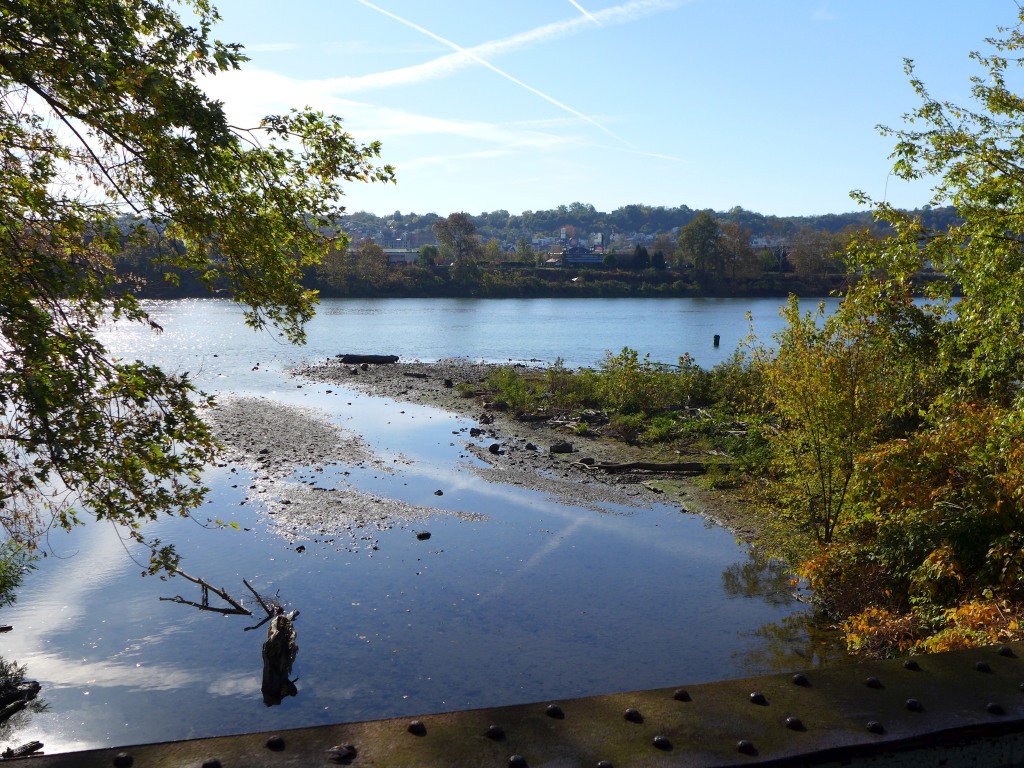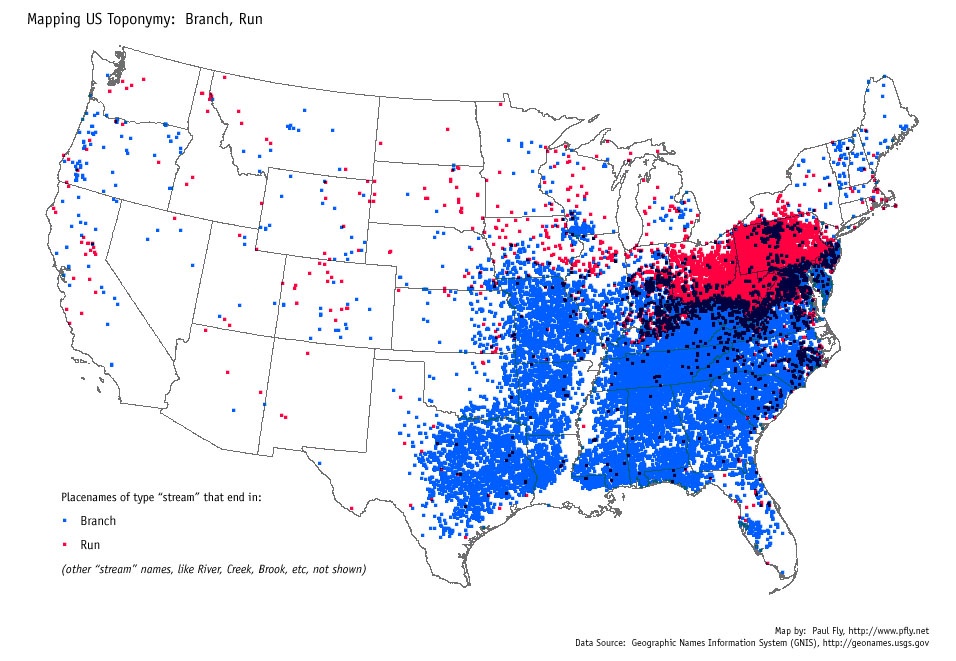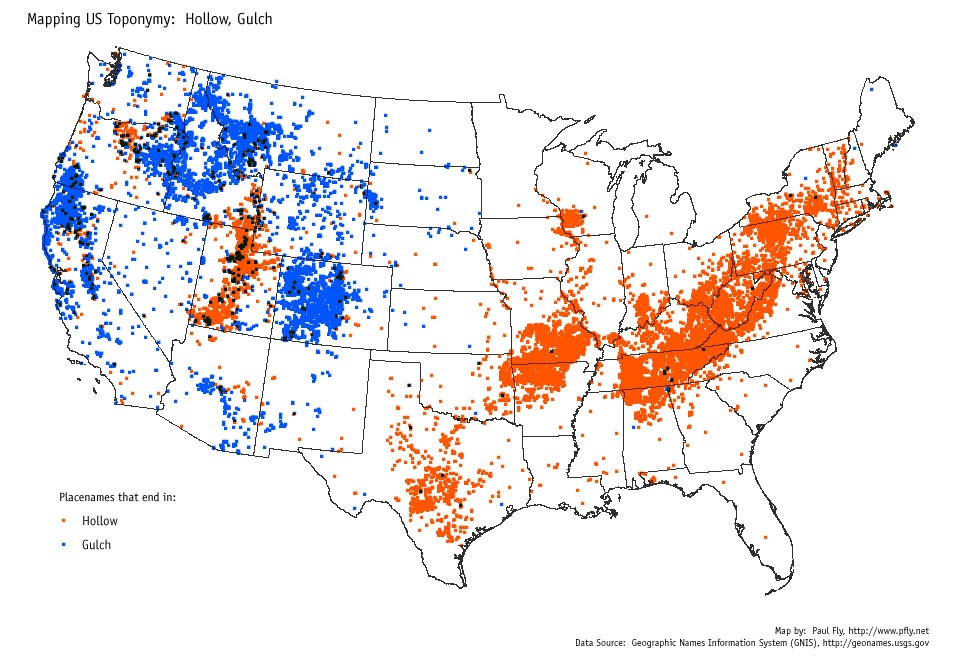
18 January 2021
At the end of yesterday’s blog post about Panther Hollow and Four Mile Run I explained a local naming convention that’s a mystery to people from other parts of the country. The noun “run” means the act of running or a route taken on a regular basis yet in Pittsburgh it also means “creek.”
A stream is called a “Run” in Pennsylvania, northern West Virginia, eastern Ohio and western Maryland. Derek Watkins’ map of Generic Terms for Streams in the Contiguous U.S., generated from GNIS data, shows the places where people use different words for Creek including: Branch, fork, run, brook, kill, stream, bayou, swamp, slough, wash, cañada, arroyo, rio. (Click here to see his map.)
— from The Rise and Fall of Panther Hollow Lake by Kate St. John
Using the Geographic Names Information System (GNIS), Pfly generated a map of just two words — “Run” in red and “Branch” in blue. South of here, Branch and Run coexist then Branch takes over.

There are other anomalies as well. Hollow, as in Panther Hollow, is our name for a narrow valley. The term is used throughout Appalachia and in places where Appalachians settled later such as the Ozarks, Utah, Texas, and parts of Oregon and Wisconsin(*). Everywhere else out West a narrow valley is a Gulch. Since the West is dry we think gulches are dry, but they don’t have to be.
Here’s Pfly’s map of Hollow in orange versus Gulch in blue.

So a Run in a Hollow could be called a Branch in a Gulch.
Nine Mile Branch at Duck Gulch is pictured at top.
It just doesn’t sound right.
(photo by Kate St. John, maps by Pfly on Flickr, Creative Commons licensing)
p.s. (*) The Hollow vs Gulch map is interesting from a Western migration perspective showing places where Appalachians settled later. For instance,
- Utah was settled by Mormons from Upstate New York.
- Parts of Texas were settled by Appalachians looking for more land. For instance, my great-grandparents emigrated from Appalachian Tennessee to northeastern Texas near the town of Paris.
- Southwestern Wisconsin uses both Branch and Hollow, terms from the southern Appalachians. Derek Watkins speculates that this patch may have come from Appalachian in-migration “during a regional lead mining boom in the early 19th century.”
Very interesting info regarding the terminology. It would be interesting to know what terms American Indians used for these features.
Mark, I know that some of our rivers and creeks have Native American names with the word River or Creek embedded. For instance, Ohio is an Iroquois word meaning “Great River”. So “Ohio River” is like saying “Great River River.”
Siouan speakers (Lakota, Dakota, etc.) use variations of the word “Mni” to refer to water more broadly, and rivers in particular. We see this in toponyms on English maps today – Minnesota is Mni Sota in Dakota, or Clear Water. Missouri derives from Siouan languages as well, but the Lakota refer to it as Mni Sosa, Dirty Water. Minnetonka, or Mni Thanka, is Great Water. So, at least in the Upper Midwest and part of the Great Plains, the term “Mni” means water.
POF – “Use” not “used” – Indigenous people still live on their traditional lands and still speak their native languages in many parts of the US and Canada. No past tense here.
It’s been fun. To me a run is a very tiny stream of water that “runs” off the hills and a “crick” is small stream that joins a larger one. Branch is the joining of larger bodies as the North Branch and the South Branch of the Potomac. (Both which run south to north and are east/west of each other.) Names also are related to where they are first named – at the origin or the insertion.
P.s. Don’t forget who settled where first. What was the language of the person who attempted to continue a native name.
Our nearest waterway (NW Wisconsin) is a branch (Balsam Branch). I always thought it was simply the branch of something bigger – now I know better! Thanks, very interesting as always.
Loretta Lynn singing about being born in Butcher Gulch wouldn’t sound right, either!
In salmon country out West the etymology references a fish spawning event, a ‘salmon run’. Probably in some spots back East as well. Another likely reason for the name is ‘to run the rapids’. A place you shoot through in a canoe with strong flowing water. Of course ‘run’ has other uses too, there’s probably ‘bootlegger’s runs’ out there as well.
Thanks for this post! I’d love to use these maps in my geography course if you don’t mind (credit given to the creator, of course) I have my students conduct a similar exercise as part of an assignment exploring the relationship between environment and language. I’ve been wondering if the geographic distribution of “gulch” might be related to the influence of Cornish miners in the camps of Colorado and Montana – we have other aspect of Cornish cultural influence, such as the legend of the Tommyknocker, that might lend some credence to that theory. It is super fascinating to me how we leave our trace on the earth through language, and I think your method of investigating it is really intuitive and approachable for people who don’t have backgrounds in linguistics or geography. Cool stuff!